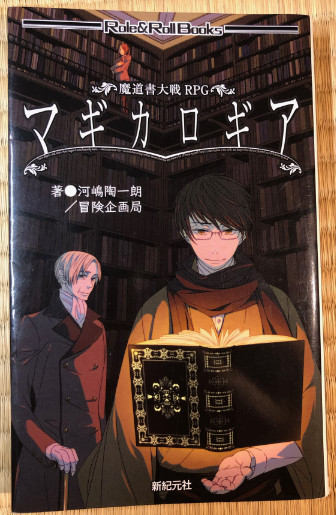
Magicalogia: The Grimoire Wars RPG (マギカロギア:魔道書対戦RPG) is a TRPG written by Toichiro Kawashima, illustrated by Torizo, and published by Adventure Planning Service. It is the fourth entry in the Dice Fiction series, which includes Shinobigami. Following the formula this series is known for, the first half of the book consists of a replay while the second half is the rules. To give a feel of what it’s like to read, I’ll follow the same general order and summarize the interesting bits.
The Physical
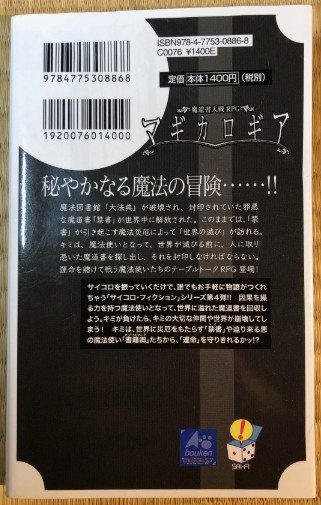
First of all, the book I have is the original core rule book. It’s now been replaced by a starter book
and a large format collected edition with expanded rules. Coming in a narrow 11cm x 17.4cm with 271 pages, 164 of those are the replay. The reverse of the jacket is also a character sheet that can be photocopied. First released in 2011, there have been a few expansions that were collected and released as a larger core rulebook. The old core book was then republished as the “starter book”.

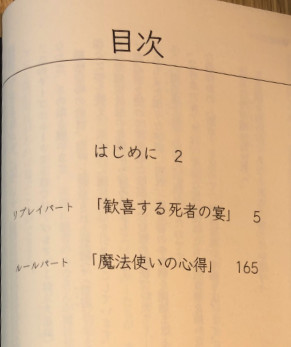
Looking through the larger edition, they put the larger page size to good use and also included a lot more info. There’s now association rules, each character archetype gets some example builds, and more spells, among other things.
Introduction
Set during a period of the Great Book War, players are associated with the “Codex” magic school and battle its enemies. Their enemies are “Bane” (禁書 forbidden books) and their “Fragments” (断章), which are loose upon the world, as well as the evil practitioners of magic “Bibliomania” (書籍卿). The game uses a transliteration of “book” for 魔道書, but another translation is grimoire.
Replay
Character Making
The replay begins making characters, with the GM giving a brief overview of the themes and explaining character concepts. The world is coming to end, but the Codex mages are trying to prevent that. The author (and GM in the replay) describes the system as an “Automated Depression Development System”…which is a bit hard to describe.
The players choose their Transient Name (仮初めの名前) and Magical Name (魔法名). The Transient Name is used when they need to interact with mundane human society. The Magical Name is obviously used in magic circles and they announce their name during magic battles.
Step into Character
Characters start at magical Stage 3, which means they’re proficient with magic to the point that they’re essentially immortal. Anchors to other people keep them alive in this world, without which they would not be able to exist. The Stage also serves as their initial Attack, Defense, and Principal stat values. While Attack and Defense are obvious, Principal is used to determine Magic Power (health).
One this this book likes to do a lot of is to use an English reading for a kanji word. For example, the word 司書 (shisho, librarian) is written, but the furigana next to it is ライブラリアン (librarian, transliterated).
Archetypes
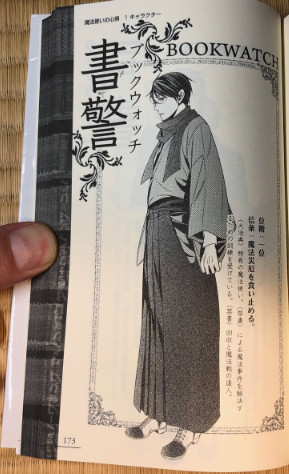
There are six character archetypes:
- Bookwatch 書警 – specialists in the retrieval of Banes
- Librarian 司書 – provides support using vast knowledge of grimoires
- Artisan 書工 – tasked with the maintenance and strengthening of grimoires
- Guest 訪問者 – people who accidentally stumbled into the world of magic
- Outsider 異端者 – naturally magical creatures
- Apocrypha 外典 – ex-Banes that have been bound to serve Codex via magic
There are six magic categories, each with eleven magic abilities, for a total of sixty-six. Players choose one of the categories as their Field of Expertise and two abilities in that Category, as well as three abilities from any categories. These represent magical domains that they are proficient in.
When using magic, 2D6 are rolled and a result of five or better is a success if the character is proficient. If not, they can substitute another ability they are proficient in, but at increased difficulty. This difficulty is calculated by the number of boxes in the ability chart they are separated by. The player also needs to explain how they’re substituting their power. For example, if proficient in “Fire”, the magician could conjure fire. If not proficient, they might still be able to do so by substituting another ability like “Eros”. If Eros is two spaces away from “Fire”, the target number increases by two.
Finally, they choose a unique custom ability and Anchor for themselves. The custom ability is like the normal magic abilities, but is whatever the player wants. They can draw upon this speciality, but at a cost to themselves. As mentioned above, the anchor is what allows the magician to exist in the world.
The Magicians
The players came up with the following characters:
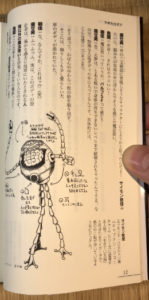 “The Thinking Pentagon”, a 120 year old “Bookwatch” magician whose body was destroyed by a Bane and they now inhabit a mechanical construct. Like most magicians, he is able to shape change at will and appear human when interacting with Fools (non-magic users, 愚者).He doesn’t have a cover story in the human world, but his transient name is Daimu Sugikoshi.
“The Thinking Pentagon”, a 120 year old “Bookwatch” magician whose body was destroyed by a Bane and they now inhabit a mechanical construct. Like most magicians, he is able to shape change at will and appear human when interacting with Fools (non-magic users, 愚者).He doesn’t have a cover story in the human world, but his transient name is Daimu Sugikoshi.
“Frater W∴M∴”, a late thirties “Librarian” who masquerades as a translator named Toujaku Kuroma.
“The Song Reflected in a Mirror”, a sixteen year old high school student magical “Visitor” that goes by the name Rikka Nagamine.
“The Rotten Riddle”, also known as Mitsu Orihime, is a 3,000 year old “Outsider.” Using the cover of a bored elementary student, her true form is that of a sphinx, who also happens to take the form of a cat and nap most of the time.
Introduction Phase
Each character, plus the Game Master, gets an introductory scene. This scene sets up their involvement in the story, and serves to join the characters together. Once each character has had a scene where they are the Scene Player, the Introduction Phase ends and the Main Phase begins.
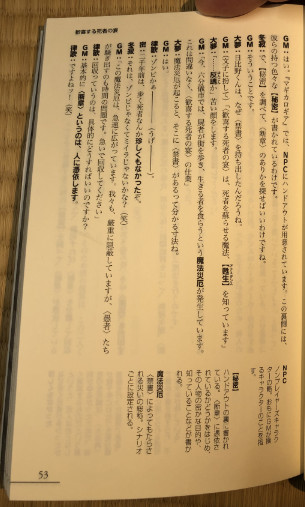
This story is set in Rokubungi City, a fictional city in Tokyo that is shared between multiple Dice Fiction titles, including Shinobigami. Originally published in Role&Roll magazine vol.78, it is also available as a PDF from the publisher’s site.
The first scene is that of The Thinking Pentagon Daimu, who awakes to find dead bodies of his students scattered around his lab. A school girl, who is actually the Bane “Bewitching King of Despair” that destroyed Daimu’s flesh a hundred years ago, stands before him and taunts him before leaving.
The other characters also have their introduction phases in which we learn an ex-Codex Librarian “Takashi Hibino” has gone missing with the Bane “Welcome Feast for the Dead.” An NPC that is important to the story is represented by a handout that is laid on the table face up. The reverse has a one or more secrets that person is hiding, which can be discovered by investigating. The Librarian on the run Hibino’s daughter and ex-wife are also NPCs that can be investigated, so they each have an NPC card. These NPCs often become Anchors for the player characters.
Main Phase
As the main phase starts, the GM explains how scenes works, as well as gives an overview of magic. Scenes in the Main Phase can be either a Drama or Battle scene. There are three types of Drama scenes. One is an Investigation, where you can learn a secret about an NPC. The second is an “Incident”, that allows a character to raise their Fate by randomly running a scene. The third is “Tuning”, which allows the recovery of Magic Power, an analog for health.
Magic works on a charge-based system, where mana is collected and casting a spell uses a set amount of mana. Magic is divided into six categories, each with eleven types. In turn, each spell belongs to one of these types. Each spell has its own mana pool. Rolling doubles during a check will provide a charge of two mana that can be assigned to spells whose type corresponds to the category on the dice.
The Rotten Riddle Mitsu
The player of Mitsu asks if he can run his scene first because he’d like to investigate the NPC Rikka (who just happens to have the same name as one of the player characters). In order to do so, he rolls on the Scene Chart to determine the setting of the scene. He rolled a seven and consulted the chart to find that a Fragment caused a magical disaster. In order to resolve, a random magic skill is determined and the target number set. If he succeeds, he gains one Mana of his choice. If he fails, a Change of Fate occurs.

The first roll of 1D6 determined that the category was “Darkness”, and a subsequent 2D6 decided on the magic “Abyss”. The GM then decided that slowly moving undead begin to appear on the streets. If Mitsu succeeds on his check, the undead will be vanquished. Not knowing Abyssal magic, he decides to substitute “Melody”, which is four spaces away and raises the target number to nine. To justify this substitution, he decides to sing a holy hymn. He succeeds on the roll and a celestial chorus fills the air, driving the undead away. Because he succeeded, he charges the spell Heal with one Mana.
Had he succeeded on his original investigation roll, he would have uncovered Rikka’s secret. Secrets can give additional clues needed to solve the case, but sometimes lead to finding an enemy. Investing a possessed person is one area that can lead to the latter.
The scenes continue until each player, including GM, has gone. After which a new cycle begins. We’ll now jump to a Battle Scene. It’s important to make sure the NPC you’re challenging to a battle is a magic user of some sort. If they’re a non-magic user (Fool), they automatically lose the battle.
Mitsu vs the Fragment “Delight”
Tracking down Hibino, Mitsu confronts him and in doing so, the Fragment “Delight” (歓喜) that is possessing him merges from Hibino. The form it takes is a statue of a goddess with translucent flesh like glass. Magic circles are drawn in game, and out of game the GM and Mitsu produce magical circle sheets, which includes a rules overview and some areas to place dice for clarity.
In a Battle Scene there is one player that becomes the main combatant against another single combatant. Allies may join as Witnesses, which may help their ally, but will also suffer damage if their ally does.
One of the unique characteristics of the replay format is that table talk is often included. This can be seen when the Fragment taunts Hibino in character, “You seized hope by taking that book, so why do you feel despair?” The player of Daimu out of game jokes that it’s “…because Hope and Despair are only separate by one square [on the magic chart]”.
A magic battle consists of the beginning of the round, first summoning step, second summoning step, first attack step, second attack step, round end. This cycle continues until there is a victor. The character that initiated the Battle scene goes first, so Mitsu will always act first for each step.
Beginning of the Round
At the beginning of each round each representative gains one mana they can use to charge a spell of their choice. One wrinkle that surprises the players is that fragments and bibliophile don’t need mana to cast spells. To this revelation Mitsu’s player responds that Mitsu is really an evil magician at heart. The GM retorts there’s a reason why so many magicians have fallen.
Summoning
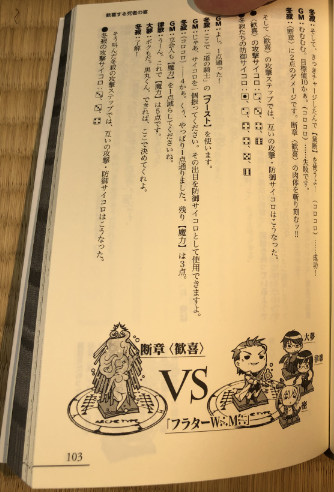
Beginning with the first representative, they can summon an Archetype to fight for them. This Archetype is determined by the summoning spell, such as “Summon Knight”. Each Archetype can provide protection or bonuses. When first choosing a summoning spell, a magic type is also chosen. So a “Summon Knight” spell tied to the “Future” magic school would result in a Future Knight being summoned. If the character doesn’t have a summon spell, they can use a “Calling” (緊急召喚) ability to randomly summon. This is more difficult because the magician may not know the magic randomly selected and have to substitute another magic, which raises the target number.
Mitsu doesn’t have a summoning spell charged with Mana, so uses “Calling” to call upon a spirit. Adding to this, he uses a special ability that allows him to summon two spirits at once, but each spirit requires a summoning roll with difficulty increased by two. He then uses the ability “True Name” to decrease the difficulty by one.
The first summon is randomly determined to be an “Illusion Spirit”, but he substitutes “Emotion” with a distance of three. Couple with the difficulty increase, he has to roll more than nine, but fails. Luckily, though, the roll was double twos, which charges the Beast magic sphere with one mana.
The second summon is randomly determined to be a “Spirit of Time”. He again substitutes “Emotion”, which results in a target number of eleven. This is an unlikely roll to make, so he calls upon his Soul’s Specialty (costing one Magic Power point) and a PC Observer uses the “Support” spell to lower the difficulty to a total of six. Mitsu unfortunately fumbles and rolls on the fumble table, losing another Magic Point and leaving him with only three Magic Points left.
It’s now the Fragment’s Summoning Step. It can’t summon, but it can cast spells, and it takes the opportunity to cast the “Spark” spell using “Light” magic. Mitsu can resist by succeeding on a “Light” magic test, but fails and takes another point of damage.
Attacking
We now move onto the attack step. Being the one to initiate combat, Mitsu attacks first and the Fragment defends. The attacker and defender respectively use their Attack and Defense stats, which indicate the number of dice they can use.
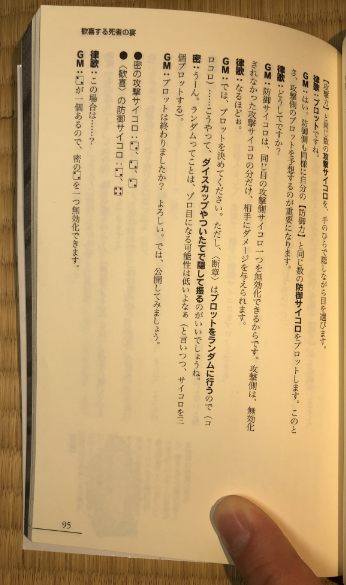
Dice aren’t rolled when attacking or defending. Instead, they’re chosen in secret (“plotted”) by the combatants and then revealed. Dice with the same number cancel each other out, with any remainders inflicting damage or providing mana to the defender. The type of mana gained is determined by the number on the die, so so there’s some strategy for considering the spells both you and your opponent can charge.
Mitsu plots three dice, all of which are twos. The Fragment plots two dice, choosing a two and a four. The Fragment’s two cancels out one of Mitsu’s twos, leaving two dice that translates to two points of damage for the Fragment, which now has four magic points (health).
On the Defense
It’s now the Fragment’s turn to attack. It has four attack dice while Mitsu only has three. Luckily for Mitsu, his friendly Observers each get one die they can plot and contribute to his defense. One of them has the “Analyze” ability, which adds an additional defense die. Allies are not allowed to consult each other when plotting dice.
The Fragment plotted one, two, two, and four. Mitsu’s defense plotted two, four, four, four, four, five, six, and six. Amazingly two of the Fragment’s dice are not cancelled out and Mitsu takes two damage while his Observers take one damage each. This damage leaves Mitsu with exactly zero magic points and losing the magic battle.
A Painful Loss
Loss doesn’t kill Mitsu, but it does cause him to rely on an Anchor to save himself. He first randomly chooses one of his Anchors, and it ends up being the boyfriend of the missing magician’s daughter. Rolling again on the Change of Fate chart, it’s determined that an accident occurred. Specifically he was in a car accident and suffered traumatic injury. If an Anchor suffers the same Change of Fate a second time, they die. The “Automated Depression Development System” in action, if you will.
Carrying On
The main phase continues on for three more cycles with more combat and investigation until the characters finally track down the Bane “Welcome Feast for the Dead.”
Climax
It’s now time for Codex to collect and Seal the Bane. The showdown takes place in a park filled with walking dead. This climatic battle follows the same steps as a normal magic battle, but the representative changes each round, with the previous representative joining the observers. They are eventually successful and we move onto the Epilogue.
Epilogue
The epilogue is where the story is wrapped up for each character in their own epilogue scene. Daimu the Thinking Pentagon, for example, has parting words with the Bane that destroyed his human body. The schoolgirl Guest magician Rikka’s scene contained a big reveal that was both reality bending and a bit confusing, even for the players, so the GM ended up explaining it in detail.
Rules
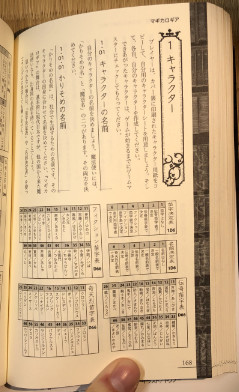
The replay itself does a good job of teaching the rules, so by the time I got to the actual rules section, it was all pretty familiar. It begins with basic game terms and then goes into character making rules. It provides a lot of charts to help choose character attributes, from names to special abilities. Most of these charts are optional and just there to help spark the imagination.
Roll them bones
Only D6s are used, so charts are based around those numbers. Similar to Dracorouge, d66 means roll two dice. In Magicalogia the tens place is determined by the lowest number, while the higher number is the ones place, which leads two twenty-one possibilities.
Spell Lists
Spells are categorized as Common, which anyone can learn, and by Character Archetype, which only characters of that archetype can learn. These range from single cast spells or summons to always-on passive abilities.

GM Goodies
Some NPC stats and a scenario are included for the GM. I skipped most of these to avoid potentially spoiling the game I was going to participate in.
Language
After struggling to read Dracurouge, I was pleasantly surprised by how easy Magicalogia is to read while still keeping its flavor. It did use some poetic or more obscure words at times, but at a manageable level. Its usage of transliteration for a lot of spell names also helped figure out the meaning of words I wasn’t familiar with.
Examples
Replay Example
A conversation in response to zombies appearing (p. 53):
密:二千年前は、歩く死者なんか珍しくもなかったぞ。
冬寂: それは、ゾンビじゃなくてミイラじゃないかな?(笑)
Mitsu: Things like the walking dead weren’t so rare 2,000 years ago.
Toujaku: Those were mummies, not zombies, right? lol
Flavor Example
Item four on the scene chart:
静かなカフェの店内。珈琲の香りと共に、優しく穏やかな雰囲気が満ちている。
Inside a quiet cafe. Along with the scent of coffee, a gentle calm fills the air.
Rules Example
From the Vanish (還送) spell:
魔法戦の自分の召喚ステップに使用できる。元型を1体目標に選ぶ。目標のレベルと等しい数だけ星の魔素を減少し、指定特技の判定を行う。成功すると目標を破壊する。
Usable on your Summoning Step in a Magic Battle. Choose one target Archetype. Decrease your Star mana by an amount equal to the level of your target and make a check for the selected ability. On a success, the target is destroyed.
Joining the Book War
A friend’s daughter ran a session of Magicalogia for my wife and I, so I’m working on a followup post about what it was like to play.
| Magicalogia (マギカロギア) | |
|---|---|
| Publisher | Adventure Planning Service (冒険企画局) |
| Author | Toichiro Kawashima (河島陶一郎) |
| Artist | Torizo (トリゾー) |
| Online Retailer | Amazon Japan |
| Released | 2011-5-10 |


This looks fantastic. The Replay part is kind of a “tutorial gameplay” of sorts, right? I think if I ever played it I’d create a guest, although outsider sounds interesting too. Thanks for all the details!
Thanks! Yeah, the Replay part is a gameplay tutorial of sorts, though not one you actively participate in. But by reading a GM and players play an actual session, it really helps capture the feeling of the game and how it flows. Outsider and Guest both seem like a lot of fun to play.